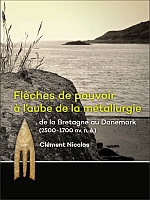Flèches de pouvoir à l’aube de la métallurgie de la Bretagne au Danemark (2500-1700 av. n. è.)
Abstract
Cette thèse porte sur les pointes de flèches découvertes dans les tombes de la fin du Néolithique et de l’âge du Bronze ancien (2500-1700 av. n. è.) dans le Massif armoricain, dans le sud des îles Britanniques et au Danemark. Ces armatures sont envisagées sous l’angle de la typologie, des matières premières, de la technologie, de l’expérimentation et de la tracéologie. L’objectif de ces différentes approches est de caractériser les modes de production et les fonctions des flèches en pierre durant une période, qui voit successivement l’introduction de la métallurgie du cuivre puis du bronze. Plusieurs interprétations sont proposées du guerrier renouvelant son carquois aux artisans fabriquant des biens de prestige destinés à l’élite. En Bretagne, les flèches sont replacées dans leur contexte culturel et social, marqué par une individualisation des pratiques funéraires puis l’émergence de chefs à la tête de communautés fortement hiérarchisées et de territoires géographiquement cohérents. Leur pouvoir paraît moins fondé sur le contrôle d’une métallurgie naissante qu’une réorganisation dans l’occupation du sol et l’exploitation des ressources agricoles. Enfin, les flèches sont mises en perspective avec les grands mouvements qui traversent l’Europe atlantique. L’origine des armatures à pédoncule et ailerons équarris de la culture campaniforme paraît ancrée dans le Néolithique final du Centre-Ouest de la France, tandis qu’à l’âge du Bronze ancien les flèches aux ailerons obliques semblent signer l’appartenance au complexe culturel atlantique. English abstract This thesis focusses on the arrowheads found in graves of Late Neolithic and Early Bronze Age date (2500-1700 BC) in the Armorican massif, the southern British Isles and Denmark. These artefacts are examined from the angle of typology, raw materials, technology, experimentation and use-wear. The aim of these different approaches is to characterize the modes of production and the functions of stone arrowheads during a period which successively sees the introduction of copper then bronze metallurgy. Several interpretations are proposed, from warriors renewing their quivers to craftsmen manufacturing prestige goods for the elite. In Brittany, the arrows are set in their cultural and social context, marked by an individualization of funerary practices and then by the emergence of chiefs at the head of strongly hierarchical communities with geographically coherent territories. Power seems founded on reorganization of land-use and exploitation of agricultural resources, rather than on control of incipient metallurgy. Lastly, arrows are placed in the broader perspective of major trends affecting Atlantic Europe. The origin of the squared-off barbed and tanged arrowheads of the Bell Beaker culture seems anchored in the Final Neolithic of west-central France, while in the Early Bronze Age the arrowheads with oblique barbs seem to indicate an attachment to the Atlantic cultural complex.
Keywords
archaeology; prehistory; neolithic; bell beaker; arrowheads; lithics; beakers; funerary archaeologyPublisher
Sidestone PressPublisher website
https://www.sidestone.com/Publication date and place
Leiden, 2016Imprint
Sidestone Press DissertationsClassification
Archaeology by period / region
Prehistory


 Download
Download Web Shop
Web Shop